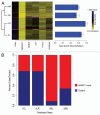Peripheral blood DNA methylation profiles are indicative of head and neck squamous cell carcinoma: an epigenome-wide association study
- PMID: 22430805
- PMCID: PMC3335952
- DOI: 10.4161/epi.7.3.19134
Peripheral blood DNA methylation profiles are indicative of head and neck squamous cell carcinoma: an epigenome-wide association study
Abstract
Head and neck cancer accounts for an estimated 47,560 new cases and 11,480 deaths annually in the United States, the majority of which are squamous cell carcinomas (HNSCC). The overall 5 year survival is approximately 60% and declines with increasing stage at diagnosis, indicating a need for non-invasive tests that facilitate the detection of early disease. DNA methylation is a stable epigenetic modification that is amenable to measurement and readily available in peripheral blood. We used a semi-supervised recursively partitioned mixture model (SS-RPMM) approach to identify novel blood DNA methylation markers of HNSCC using genome-wide methylation array data for peripheral blood samples from 92 HNSCC cases and 92 cancer-free control subjects. To assess the performance of the resultant markers, we constructed receiver operating characteristic (ROC) curves and calculated the corresponding area under the curve (AUC). Cases and controls were best differentiated by a methylation profile of six CpG loci (associated with FGD4, SERPINF1, WDR39, IL27, HYAL2 and PLEKHA6), with an AUC of 0.73 (95% CI: 0.62-0.82). After adjustment for subject age, gender, smoking, alcohol consumption and HPV16 serostatus, the AUC increased to 0.85 (95% CI: 0.76-0.92). We have identified a novel blood-based methylation profile that is indicative of HNSCC with a high degree of accuracy. This profile demonstrates the potential of DNA methylation measured in blood for development of non-invasive applications for detection of head and neck cancer.
Figures




References
MeSH terms
Substances
Grants and funding
LinkOut - more resources
Full Text Sources
Other Literature Sources
Medical
Miscellaneous
